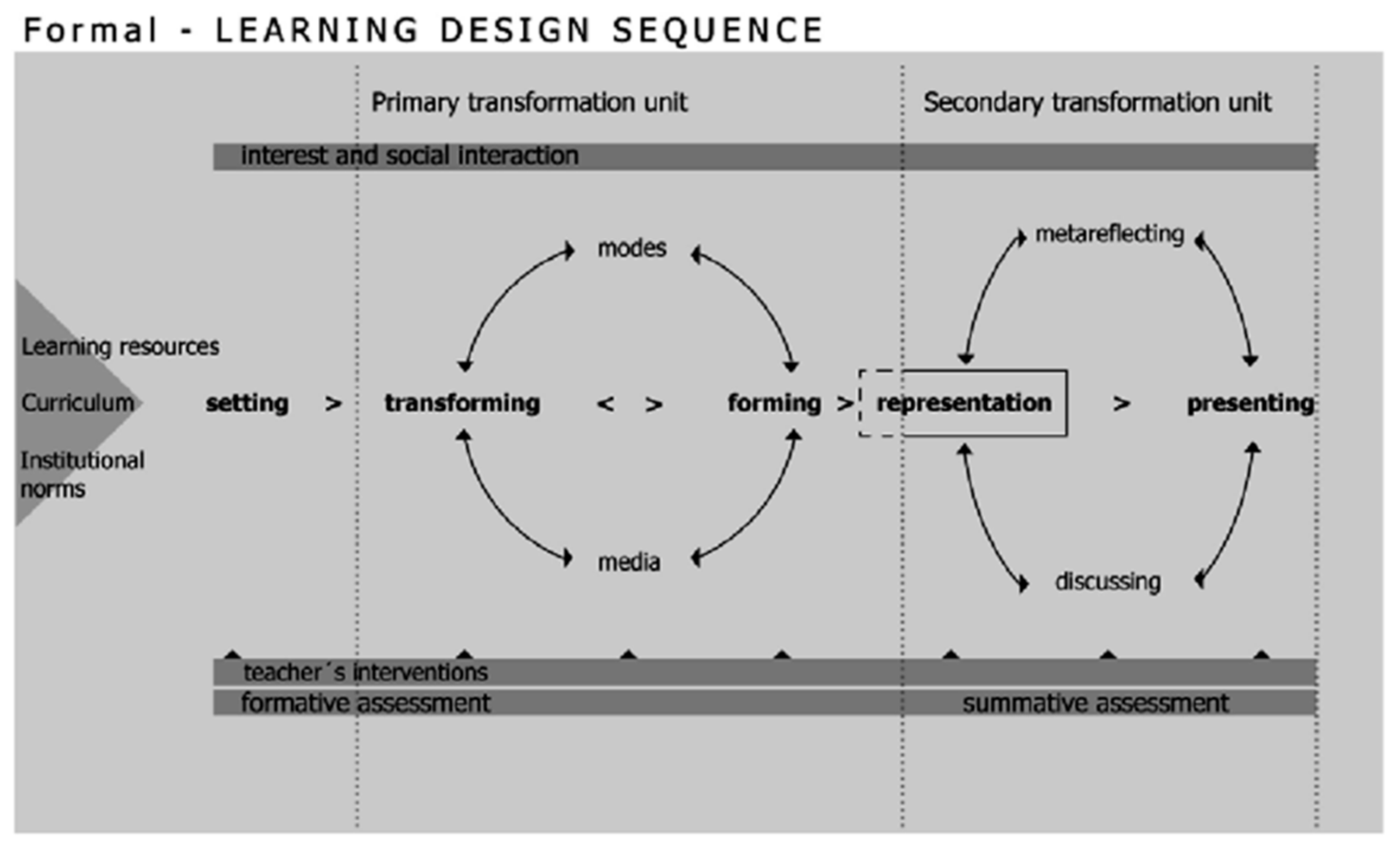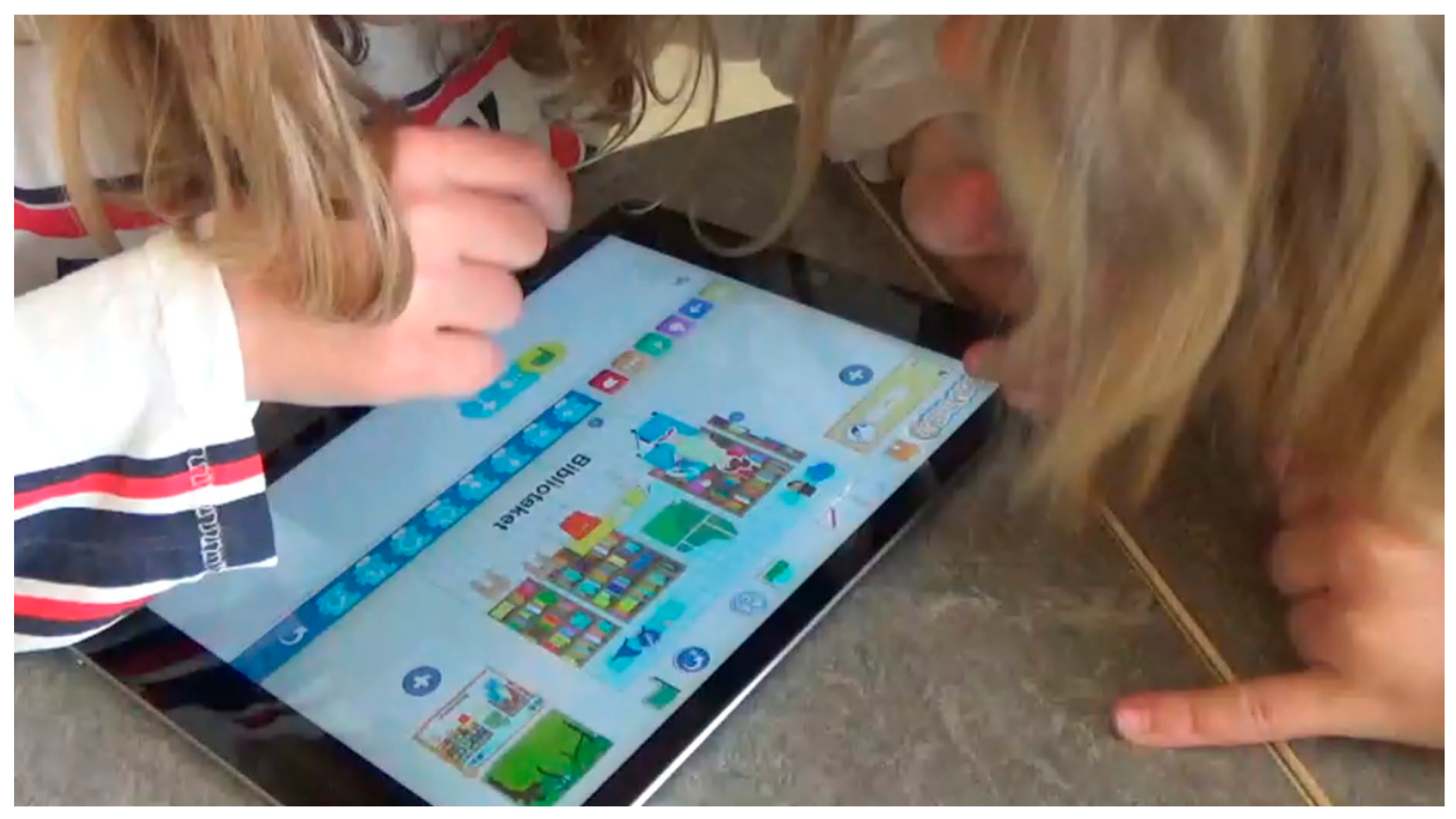Elementary Students’ First Approach to Computational Thinking and Programming
Abstract
:1. Introduction
1.1. Programming as a Key Competence—Also for Young Pupils
1.2. Physical and Visual Aspects of Programming—And How It Relates to Learning
1.3. Learning CT and Programming—A Matter of Attitudes and Collaboration?
1.4. CT and Programming—How Early Can They Be Introduced?
1.5. The National Curriculum and Learning
1.6. Aim and Research Questions
- How do young pupils engage in computational thinking in a Learning Design Sequence?
- How can young pupils’ multimodal signs of learning be visualized in programming activities?
1.7. Theoretical Approach
2. Materials and Methods
3. Results
3.1. Setting—Designs for Learning
3.2. Primary Transformation Unit—Learning, Transforming and Forming
- To control a character.
- A remote control.
- An app to run a bike.
- To check instructions and build Lego.
- Why do you have to do programming?
- How do you control robots by remote control?
- How long is the world’s longest programming track?
- “Programming!”
- “How to program in different ways!”
- “With patterns!”
- “Instead of letters they read ones and zeros that becomes letters…”
“Here comes the guideline, and it is as follows: You shall make your character walk five steps forward and make a jump. And then, it is like this, that when you have made that code, you shall hand in your iPads, and I will see, we will see, if you have made that code.”
3.3. Secondary Transformation Unit—Learning, Metareflection and Discussion
“Five steps and then it jumps up into the air and stays there: good!”
“It doesn’t matter!”
“You did a programming activity, absolutely, but it was not according to the instruction. You made your own guideline, your own code, which was 5 forward, 5 turn arounds, and then that is supposed to repeat over and over again, or it shall repeat five times. That was the instruction that you were given. But, you did not follow the one that the class was supposed to do. You made your own.”
3.4. Secondary Transformation Unit—Attitudes, Learning and Meta Reflection
4. Discussion
5. Conclusions
Author Contributions
Funding
Institutional Review Board Statement
Informed Consent Statement
Data Availability Statement
Acknowledgments
Conflicts of Interest
References
- Kjällander, S. Plattan i Mattan: Digitala lärplattor Och Didaktisk Design i Förskolan. Forskningsrapport. Uppsala Vård & Bildning. Available online: www.uppsala.se (accessed on 4 March 2016).
- Wing, J. Computational thinking. Commun. ACM 2006, 49, 33–36. [Google Scholar] [CrossRef]
- Mannila, L.; Dagiene, V.; Demo, B.; Grgurina, N.; Mirolo, C.; Rolandsson, L.; Settle, A. Computational Thinking in K-9 Education. In Proceedings of the 2014 Conference on Innovation & Technology in Computer Science Education (ITiCSE ‘14), Uppsala, Sweden, 23–25 June 2014; pp. 1–29. [Google Scholar]
- Regeringen. Nationell Digitaliseringsstrategi för Skolväsendet; Bilaga Till Regeringsbeslut I; Swedish Government: Stockholm, Sweden, 2017; Volume 1. [Google Scholar]
- Heintz, F.; Mannila, L.; Nordén, L.; Parnes, P.; Björn, R. Introducing Programming and Digital Competence in Swedish K–9 Education. In Informatics in Schools: Focus on Learning Programming, Proceedings of the Informatics in Schools: Focus on Learning Programming: 10th International Conference on Informatics in Schools: Situation Evolution and Perspective (ISSEP), Helsinki, Finland, 13–15 November 2017; Lecture Notes in Computer Science #10696; Valentina, D., Arto, H., Eds.; Springer: Berlin/Heidelberg, Germany, 2017; pp. 117–128, ISBN 9783319714820, 9783319714837. [Google Scholar]
- Cervera, N.; Diago, P.D.; Orcos, L.; Yáñez, D.F. The Acquisition of Computational Thinking through Mentoring: An Exploratory Study. Educ. Sci. 2020, 10, 202. [Google Scholar] [CrossRef]
- European Schoolnet. Computing our Future–Computer Programming and Coding Priorities, School Curricula and Initiatives across Europe. Publisher: European Schoolnet Brussels: BelgiumPublished: October 2015. Available online: http://www.eun.org (accessed on 15 February 2021).
- Lye, S.Y.; Koh, J.H.L. Review on teaching and learning of computational thinking through programming: What is next for K-12? Comput. Hum. Behav. 2014, 41, 51–61. [Google Scholar] [CrossRef]
- Sapounidis, T.; Demetriadis, S. Tangible versus graphical user interfaces for robot programming: Exploring cross-age children’s preferences. Pers. Ubiquitous Comput. 2013, 17, 1775–1786. [Google Scholar] [CrossRef]
- Kazakoff, E.R.; Sullivan, A.; Bers, M.U. The Effect of a Classroom-Based Intensive Robotics and Programming Workshop on Sequencing Ability in Early Childhood. Early Child. Educ. J. 2013, 41, 245–255. [Google Scholar] [CrossRef]
- Bers, M.U. The TangiableK robotics program: Applied computational thinking for young children. Early Child. Reasearch Pract. 2010, 12, 1524–1539. [Google Scholar]
- Sáez-López, J.M.; Román-González, M.; Vázquez-Cano, E. Visual programming languages integrated across the curriculum in elementary school: A two year case study using “Scratch” in five schools. Comput. Educ. 2016, 97, 129–141. [Google Scholar] [CrossRef]
- Regnell, B.; Pant, L.; Teaching Programming to Young Learners Using Scala and Kojo. LTHs 8:e Pedagogiska Inspirationskonferens. Available online: http://lup.lub.lu.se/record/4780249 (accessed on 17 December 2014).
- Robertson, J.; Howells, C. Computer game design: Opportunities for successful learning. Comput. Educ. 2008, 50, 559–578. [Google Scholar] [CrossRef]
- Christensen, D.J.; Fogh, R.; Lund, H.H. Playte, a tangible interface for engaging human-robot interaction. In Proceedings of the Robot and Human Interactive Communication, RO-MAN: The 23rd IEEE International Symposium, Edinburgh, UK, 25–29 August 2014; pp. 56–62. [Google Scholar]
- Israel, M.; Pearson, J.N.; Tapia, T.; Wherfel, Q.M.; Reese, G. Supporting all learners in school-wide computational thinking: A cross-case qualitative analysis. Comput. Educ. 2015, 82, 263–279. [Google Scholar] [CrossRef]
- Tran, Y. Computational thinking equity in elementary classrooms: What third-grade students know and can do. J. Educ. Comput. Res. 2019, 57, 3–31. [Google Scholar] [CrossRef]
- Palmér, H. Programming in preschool with a focus on learning mathematics. Int. Res. Early Child. Educ. 2017, 8, 75–87. [Google Scholar]
- Irish, T.; Kang, N.-H. Connecting classroom science with everyday life: Teachers’ attempts and students’ insights. Int. J. Sci. Math. Educ. 2018, 16, 1227–1245. [Google Scholar] [CrossRef]
- National Agency for Education. Curriculum for the Compulsory School, Preschool Class and School-Age Educare; (Revised 2018); Skolverket: Stockholm, Sweden, 2019; ISBN 978-913832734-0. Available online: https://www.skolverket.se/publikationer?id=3984 (accessed on 15 February 2021).
- State Media Council. Småungar Och Medier 2019. Publication date: 10 September 2019. Available online: https://statensmedierad.se/publikationer/ungarochmedier/smaungarochmedier2019.3348.html (accessed on 15 February 2021).
- Martinez, C.; Gomez, M.J.; Benotti, L. A comparison of preschool and elementary school children learning computer science concepts through a multilanguage robot programming platform. In Proceedings of the 2015 ACM Conference on Innovation and Technology in Computer Science Education, Vilnius, Lithuania, 6–8 July 2015; pp. 159–164. [Google Scholar]
- Kjällander, S.; Riddersporre, B. Digitalisering i en Förskola på Vetenskaplig Grund; Natur & Kultur: Stockholm, Sweden, 2019. [Google Scholar]
- Heintz, F.; Mannila, L. Computational Thinking for All An Experience Report on Scaling up Teaching Computational Thinking to All Students in a Major City in Sweden. In Proceedings of the 49th ACM Technical Symposium on Computer Science Education (SIGCSE), Association for Computing Machinery (ACM), Baltimore, MD, USA, 21–24 February 2018; Association for Computing Machinery: New York, NY, USA; pp. 137–142. ISBN 978-1-4503-5103-4.
- Kress, G. Multimodality: A Social Semiotic Approach to Contemporary Communication; Routledge: London, UK, 2010. [Google Scholar]
- van Leeuwen, T. Introducing Social Semiotics; Routledge: London, UK, 2005. [Google Scholar]
- Selander, S. Didaktisk Design. In Didaktisk Design i Digital Miljö nya Möjligheter för Lärande; Selander, S., Svärdemo-Åberg, E., Eds.; Liber: Stockholm, Sweden, 2009. [Google Scholar]
- Jewitt C, E. The Routledge Handbook of Multimodal Analysis; Routledge: New York, NY, USA, 2009. [Google Scholar]
- Selander, S. Didaktiken Efter Vygotskij: Design för Lärande; Liber: Stockholm, Sweden, 2017. [Google Scholar]
- Selander, S.; Kress, G. Design för Lärande: Ett Multimodalt Perspektiv; Norstedts Akademiska Förlag: Stockholm, Sweden, 2010. [Google Scholar]
- Kress, G. What is mode? I: C. Jewitt (red.). In The Routledge Handbook of Multimodal Analysis; Routledge: London, UK; New York, NY, USA, 2009. [Google Scholar]
- Gibson, J.J. The Ecological Approach to Visual Perception; Houghton Mifflin: Boston, MA, USA, 1979. [Google Scholar]
- Leifheit, L.; Tsarava, K.; Moeller, K.; Ostermann, K.; Golle, J.; Trautwein, U.; Ninaus, M. Development of a questionnaire on self-concept, motivational beliefs, and attitude towards programming. In Proceedings of the 14th Workshop in Primary and Secondary Computing Education, WiPSCE’19, Glasgow, Scotland, 23–25 October 2019. [Google Scholar]
- Mannila, L.; Heintz, F.; Kjällander, S.; Åkerfeldt, A. Programming in primary education: Towards a research based assessment framework. In Proceedings of the Woodstock ’18: ACM Symposium on Neural Gaze Detection, Woodstock, NY, USA, 3–5 June 2018; ACM: New York, NY, USA, 2020. [Google Scholar] [CrossRef]
- Shaffer, D.W. How Computer Games Help Children Learn; Palgrave Macmillan: New York, NY, USA, 2006. [Google Scholar]
- Häiikilä, M. Vad händer när roboten får ögonfransar? Genusperspektiv på programmering i förskolan. In Digitalisering i en Förskola på Vetenskaplig Grund; Kjällander, S., Riddersporre, B., Eds.; Natur & Kultur: Stockholm, Sweden, 2019. [Google Scholar]
- Palmer, A. Hur Blir Man Matematisk?: Att Skapa Nya Relationer Till Matematik Och Genus i Arbetet Med Yngre Barn; Liber: Stockholm, Sweden, 2011. [Google Scholar]
- Krosnick, J.A. Survey research. Annu. Rev. Psychol. 1999, 50, 537–567. [Google Scholar] [CrossRef] [PubMed]






| True | Somewhat true | Not at all true | Do not know | |
|---|---|---|---|---|
| Programming is fun. | 79.3 % | 17.2 % | 1.7 % | 1.7 % |
| Programming is difficult | 22.4 % | 43.1 % | 20.7 % | 13.8 % |
| I would like to have more programming in school. | 65.5 % | 20.7 % | 5.2 % | 8.6 % |
| I am skilled at programming. | 48.3 % | 32.8 % | 10.3 % | 8.6 % |
Publisher’s Note: MDPI stays neutral with regard to jurisdictional claims in published maps and institutional affiliations. |
© 2021 by the authors. Licensee MDPI, Basel, Switzerland. This article is an open access article distributed under the terms and conditions of the Creative Commons Attribution (CC BY) license (http://creativecommons.org/licenses/by/4.0/).
Share and Cite
Kjällander, S.; Mannila, L.; Åkerfeldt, A.; Heintz, F. Elementary Students’ First Approach to Computational Thinking and Programming. Educ. Sci. 2021, 11, 80. https://doi.org/10.3390/educsci11020080
Kjällander S, Mannila L, Åkerfeldt A, Heintz F. Elementary Students’ First Approach to Computational Thinking and Programming. Education Sciences. 2021; 11(2):80. https://doi.org/10.3390/educsci11020080
Chicago/Turabian StyleKjällander, Susanne, Linda Mannila, Anna Åkerfeldt, and Fredrik Heintz. 2021. "Elementary Students’ First Approach to Computational Thinking and Programming" Education Sciences 11, no. 2: 80. https://doi.org/10.3390/educsci11020080
APA StyleKjällander, S., Mannila, L., Åkerfeldt, A., & Heintz, F. (2021). Elementary Students’ First Approach to Computational Thinking and Programming. Education Sciences, 11(2), 80. https://doi.org/10.3390/educsci11020080







